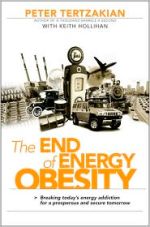 I thought it would be apropos to tie this week’s book review into a common New Year’s resolution -weight loss. Enter “The End of Energy Obesity,” by Peter Tertzakian. While this book has the same theme as most energy books these days, breaking America’s energy addiction, it varied from the most common used parallels and likened our country’s energy addiction to our country’s food addiction. It is an effective analogy.
I thought it would be apropos to tie this week’s book review into a common New Year’s resolution -weight loss. Enter “The End of Energy Obesity,” by Peter Tertzakian. While this book has the same theme as most energy books these days, breaking America’s energy addiction, it varied from the most common used parallels and likened our country’s energy addiction to our country’s food addiction. It is an effective analogy.
Tertzakian writes, “Over the last decade, specifically in North America, our energy appetite has soared to such an extent that we are now energy obese.”
Throughout the book, Tertzakian outlines how America became energy obese as well as the way our country can curb its energy appetite as this will need to be done, in part, through a new energy diet that is compelling. He explains that energy sources, both renewable and nonrenewable will need to meet nine energy attributes. The higher the score, the better chance the energy source has of being successfully incorporated into our energy diet. The nine attributes include: versatility, scalability, storability and transportability, deliverability, energy density, power density, constancy, environmental sensitivity, and energy security. Ultimately, Tertzakian feels that renewable energy has limited potential and his winning solution is increasing the use of natural gas.
For the most part, he stays the course with his metapor through the first two parts but he begins to wander off topic in part three as he delves into conservation, dissolving distance and the development of communication technologies. I also disagree with him in the sense that relying on an increase in natural gas is not the best way to go. Natural gas is a limited resource that fluctuates heavily in terms of pricing. An increase in the use of this energy source could cause our energy prices to become even more volitale. Yes, energy prices will increase as we ramp up the integration of alternative energy sources but over the long-term, prices will become more stable than they are now.
Ultimately the book presents some interesting ideas to mull over but if you’re short of time, just focus on the first half of the book. To read this book or any book I review, click here.

